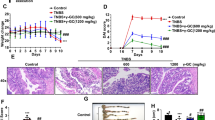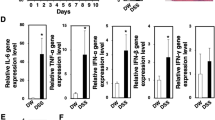Abstract
Macrophages (MPs) produce increased levels of proinflammatory cytokines in Crohn’s disease; these cytokines are thought to play a central role in the occurrence of the disease. Biologics are currently available for anti-cytokine therapy, but treating intestinal inflammation through direct suppression of proinflammatory cytokine production could be more effective. P-ATPase inhibitors have been reported to be anti-inflammatory, and these inhibitors might suppress the production of MP proinflammatory cytokines. In this study, we examined the effect of two types of ATPase inhibitors on the expression patterns of typical proinflammatory cytokines. Peritoneal MPs from 6- to 8-week-old mice were cultured for 48 h in the presence of lansoprazole (P-ATPase inhibitor), bafilomycin A1 (V-ATPase inhibitor), or the control solvent dimethylsulfoxide. The MPs were then examined for cytokine expression by quantitative real-time polymerase chain reaction (PCR), and culture supernatants were examined for cytokine production with a multiplex assay in a suspension array system. The possible existence of P-ATPase mRNA in MPs was explored using reverse-transcriptase PCR. P-ATPase mRNA was not detected in MP cells. However, all examined proinflammatory cytokines decreased significantly in their mRNA and protein expression in the lansoprazole-treated group. Conversely, bafilomycin A1 increased the levels of these cytokines. Lansoprazole might be useful for the treatment of inflammatory bowel diseases (IBDs), including Crohn’s disease, as it suppresses the production of relevant MP proinflammatory cytokines. However, because P-ATPase was not detected in MPs, the mechanism is unclear and remains to be studied further in an IBD animal model.





Similar content being viewed by others
References
Mahida YR (2000) The key role of macrophages in the immunopathogenesis of inflammatory bowel disease. Inflamm Bowel Dis 6:21–33
Sawa Y, Oshitani N, Adachi K et al (2003) Comprehensive analysis of intestinal cytokine messenger RNA profile by real-time quantitative polymerase chain reaction in patients with inflammatory bowel disease. Int J Mol Med 11:175–179
Ogata H, Hibi T (2003) Cytokine and anti-cytokine therapies for inflammatory bowel disease. Curr Pharm Des 9:1107–1113
Hibi T, Inoue N, Ogata H et al (2003) Introduction and overview: recent advances in the immunotherapy of inflammatory bowel disease. J Gastroenterol 38:36–42
Baert F, Noman M, Vermeire S et al (2003) Influence of immunogenicity on the long-term efficacy of infliximab in Crohn’s disease. N Engl J Med 348:601–608
Ito H (2005) Treatment of Crohn’s disease with anti-IL-6 receptor antibody. J Gastroenterol 40:32–34
Ito H, Takazoe M, Fukuda Y et al (2004) A pilot randomized trial of a human anti-interleukin-6 receptor monoclonal antibody in active Crohn’s disease. Gastroenterology 126:989–996
Yoshida N, Yoshikawa T, Tanaka Y et al (2000) A new mechanism for anti-inflammatory actions of proton pump inhibitors-inhibitory effects on neutrophil-endothelial cell interactions. Aliment Pharmacol Ther 14:74–81
Ohara T, Arakawa T (1999) Lansoprazole decreases peripheral blood monocytes and intercellular adhesion molecule-1-positive mononuclear cells. Dig Dis Sci 44:1710–1715
Bicakci U, Tander B, Ariturk E et al (2005) Effects of omeprazole and gentamicin on the biochemical and histopathological alterations of the hypoxia/reoxygenation induced intestinal injury in newborn rats. Pediatr Surg Int 21:800–805
Suzuki M, Mori M, Miura S et al (1996) Omeprazole attenuates oxygen-derived free radical production from human neutrophils. Free Radic Biol Med 21:727–731
Wandall JH (1992) Effects of omeprazole on neutrophil chemotaxis, super oxide production, degranulation, and translocation of cytochrome b-245. Gut 33:617–621
Suzuki M, Nakamura M, Mori M et al (1995) Lansoprazole inhibits oxygen-derived free radical production from neutrophils activated by Helicobacter pylori. J Clin Gastroenterol 20:93–96
Dickinson JB (1994) Is omeprazole helpful in inflammatory bowel disease? J Clin Gastroenterol 18:317–319
Valori RM, Cockel R (1990) Omeprazole for duodenal ulceration in Crohn’s disease. BMJ 300:438–439
Forgac M (1989) Structure and function of vacuolar class of ATP-driven proton pumps. Physiol Rev 69:765–796
Nelson N (1989) Structure, molecular genetics, and evolution of vacuolar H+-ATPases. J Bioenerg Biomembr 21:553–571
Moriyama Y, Futai M (1990) H(+)-ATPase, a primary pump for accumulation of neurotransmitters, is a major constituent of brain synaptic vesicles. Biochem Biophys Res Commun 173:443–448
Vaananen HK, Karhukorpi EK, Sundquist K et al (1990) Evidence for the presence of a proton pump of the vacuolar (H+)-ATPase type in the ruffled borders of osteoclasts. J Cell Biol 111:1305–1311
Martinez-Zaguilan R, Lynch RM, Martinez GM et al (1993) Vacuolar-type H(+)-ATPases are functionally expressed in plasma membranes of human tumor cells. Am J Physiol 265:1015–1029
Yoshimura K, Kametani F, Shimoda Y et al (2001) Antigens of monoclonal antibody NB3C4 are novel markers for oligodendrocytes. Neuroreport 12:417–421
Bunge RP, Wood P (1973) Studies on the transplantation of spinal cord tissue in the rat. Ι. The development of a culture system for hemisections of embryonic spinal cord. Brain Res 57:261–276
Carmosino M, Mazzone A, Laforenza U et al (2005) Altered expression of aquaporin 4 and H(+)/K(+)-ATPase in the stomachs of peptide YY(PYY)transgenic mice. Biol Cell 97:735–742
Yamamoto M, Yoshizaki K, Kishimoto T et al (2000) IL-6 is required for the development of Th1 cell-mediated murine colitis. J Immunol 164:4878–4882
Ito H, Hirotani T, Yamamoto M et al (2002) Anti-IL-6 receptor monoclonal antibody inhibits leukocyte recruitment and promotes T-cell apoptosis in a murine model of Crohn’s disease. J Gastroenterol 37:56–61
Nakamura M, Asada M, Atsuda K et al (2005) Lansoprazole binding to the neutrophils in dextran sulfate sodium-induced rat colitis. Inflammopharmacology 13:303–315
Kuroda M, Yoshida N, Ichikawa H et al (2006) Lansoprazole, a proton pump inhibitor, reduces the severity of indomethacin-induced rat enteritis. Int J Mol Med 17:89–93
Ohta T, Numata M, Yagishita H et al (1996) Expression of 16 kDa proteolipid of vacuolar-type H(+)- ATPase in human pancreatic cancer. Br J Cancer 73:1511–1517
Bidani A, Reisner BS, Haque AK et al (2000) Bactericidal activity of alveolar macrophages is suppressed by V-ATPase inhibition. Lung 178:91–104
Acknowledgments
We are thankful to Mrs. Kayoko Tanaka, Division of Morphological Science, Saitama Medical School for her collaboration in this research. The experiments reported in this article were carried out after the approval of The Animal Research Committee of Saitama Medical School (approval no. 000368) and are in compliance with the current laws of Japan.
Author information
Authors and Affiliations
Corresponding author
Rights and permissions
About this article
Cite this article
Hinoki, A., Yoshimura, K., Fujita, K. et al. Suppression of proinflammatory cytokine production in macrophages by lansoprazole. Pediatr Surg Int 22, 915–923 (2006). https://doi.org/10.1007/s00383-006-1767-8
Published:
Issue Date:
DOI: https://doi.org/10.1007/s00383-006-1767-8




